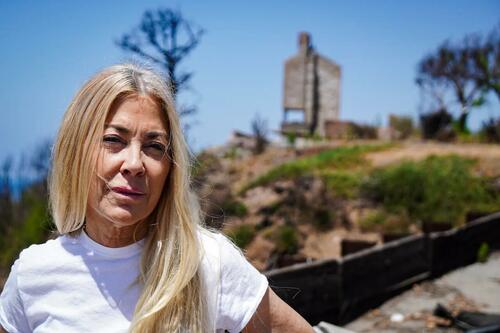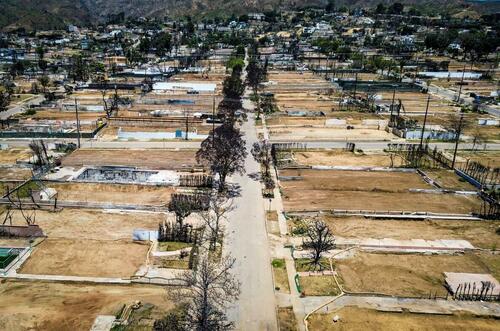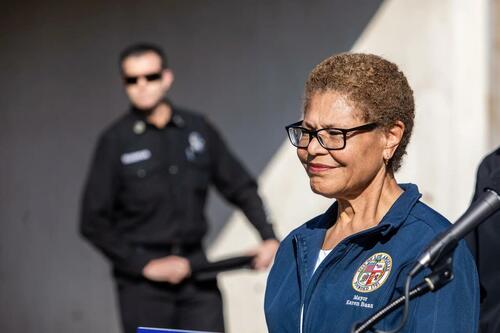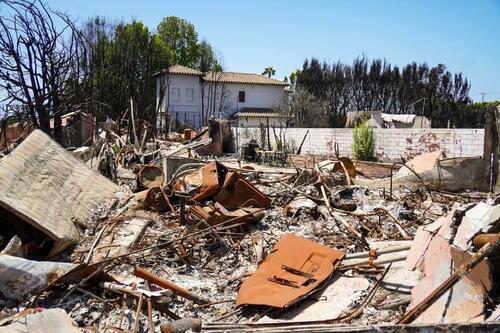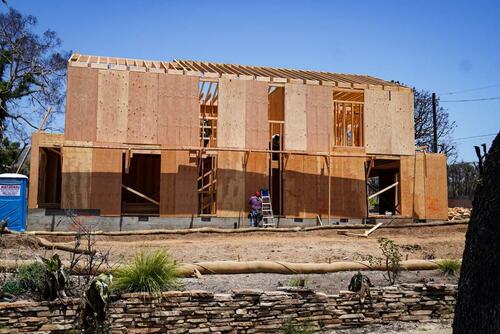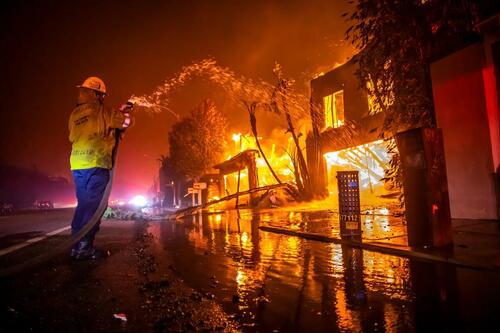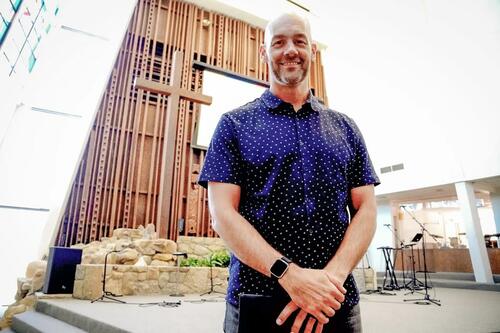

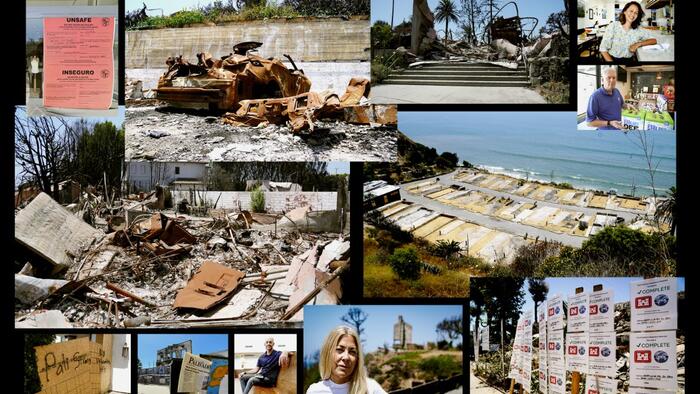
Authored by Allen Stein via The Epoch Times,
Elaine Culotti built her career as a real estate developer in Pacific Palisades, a prestigious enclave west of Los Angeles, renowned for its breathtaking coastline and multi-million-dollar mansions.
More than six months after the Palisades Fire devastated her community, Culotti is still struggling to come to terms with the aftermath.
Culotti’s oceanfront home sustained significant damage, but some of her neighbors and clients lost everything.
“My place burned. My perimeter walls burned. My deck burned. My gym burned,” Culotti said.
She also must remove 10 scorched trees from her property before her family can return.
Destruction now overshadows the once-picturesque community that is home to 23,837 people. Like sparse seedlings blooming in a charred forest, only a few signs of rebuilding are visible.
The wildfires in Los Angeles County began on Jan. 7 and continued for more than three weeks, pushing first responders to their limit and a scramble for scarce water supplies. The fires resulted in the deaths of 30 residents, forced more than 200,000 to evacuate their homes, and rendered entire neighborhoods uninhabitable.
Accusations and blame led to the dismissal of Los Angeles Fire Chief Kristin Crowley, along with calls for Los Angeles Mayor Karen Bass’s resignation, as a federal investigation was launched to determine the cause of one of the state’s worst mass casualty fires.
Having lived in Pacific Palisades for more than 25 years, Culotti understands that things will never return to how they once were.
The damage is extensive, with many old landmarks reduced to their foundations or rubble.
High rebuilding costs have forced many residents to relocate, either temporarily or permanently—people whom Culotti knew and helped to build their homes.
On a beautiful, sunny morning around the Fourth of July, Culotti drove past the charred ruins of her community, with many parts left untouched after the U.S. Army Corps of Engineers departed on June 1.
“I think it’s going to take 10 years [to rebuild], but it will be unrecognizable. Everything will be worth 10 times what it is today,” Culotti said.
Pacific Palisades real estate developer Elaine Culotti stands in front of destroyed home on July 3, 2025. Culotti’s oceanfront home suffered significant damage in the Palisades Fire. Allan Stein/The Epoch Times
The army teams only worked on properties where owners opted into the public cleanup program. Those who did not participate are responsible for their cleanup costs, she said.
A total of 9,873 property owners took part in the cost-free program run by the army. Treated locations display signs that confirm it is safe to reenter.
In the Palisades Fire, the California Department of Forestry and Fire Protection (CAL FIRE) reported that 6,662 structures were lost, 890 were damaged, and 12 people died.
When combined with the nearby Eaton Fire, which ignited in Altadena, north of Los Angeles, on Jan. 7 and claimed 18 lives, the two fires destroyed more than 12,000 structures.
“I have friends who lost homes that were 90 percent complete,“ Culotti told The Epoch Times. ”These were brand-new homes. There’s a handful of houses where people are afraid to move back in because of the toxic waste.”
In January, the Bureau of Alcohol, Tobacco, Firearms and Explosives (ATF) dispatched its National Response Team (NRT) to assist in investigating the Pacific Palisades fire, along with local law enforcement. Fifteen members of the ATF arrived in Los Angeles to help investigate the fire.
The team includes agents, chemists, engineers, and research specialists. Their job is to determine where the fire began and why it occurred.
The ATF confirmed in an email to The Epoch Times that the investigation is still ongoing.
In July, the county launched a plan for reconstruction, titled LA County Forward: Blueprint for Rebuilding. It is an outline for building back faster by streamlining the permit process and lowering construction costs.
The county also made available $51 million in direct financial support to homeowners, businesses, and nonprofits, while deferring or refunding planning and permit fees often exceeding $20,000 per household.
“As debris removal concludes and reconstruction accelerates, many more residents are facing a new set of challenges as they prepare to break ground,” according to the plan.
“Every reconstruction project is unique, but many residents are confronting similar issues at the same time. For first-time rebuilders particularly, these include navigating a complex permitting process and evaluating the financial ability to rebuild, among others.”
The county recently started the eCheck AI Pilot, a software tool to help speed up rebuilding. The fires damaged or destroyed more than 18,000 homes.
State and county officials say their residential cleanup effort was the fastest in U.S. history, removing 2.5 million tons of debris from more than 10,000 properties in just over 70 days.
After the fires began, Crowley criticized the mayor’s handling of the emergency response after a $7 million cut to the department’s overtime budget.
Crowley said that reduced funding could adversely affect crucial operations, including fire prevention.
Bass also said her decision to travel to Ghana on a diplomatic trip after forecasters had warned of dangerous fire weather conditions in the days leading up to Jan. 7 was a mistake. Bass returned to Los Angeles the day after the fires erupted, but City Council President Marqueece Harris-Dawson, acting as mayor, had to sign the proclamation of a local emergency.
On Feb. 21, Bass dismissed Crowley and appointed former chief deputy Ronnie Villanueva, 41, as the interim fire chief.
The property lines of homes burned during the Palisades Fire in the Pacific Palisades neighborhood of Los Angeles on June 9, 2025. The California Department of Forestry and Fire Protection reported that 6,662 structures were lost, and 890 were damaged in the Palisades Fire. John Fredricks/The Epoch Times
In a statement, the mayor explained that her decision was made in the best interests of public safety.
“We know that 1,000 firefighters that could have been on duty on the morning the fires broke out were instead sent home on Chief Crowley’s watch,” Bass wrote.
“Furthermore, a necessary step to an investigation was the President of the Fire Commission telling Chief Crowley to do an after-action report on the fires. The chief refused. These require her removal.”
Countywide, the wildfires burned nearly 48,000 acres in the communities of Palisades, Eaton, Lidia, Hurst, Sunset, Woodley, and Hughes.
A UCLA study estimated the economic cost of the fires to be between $76 billion and $131 billion, with insured losses reaching up to $45 billion.
On June 25, Newsom—who declared a state of emergency for Los Angeles County on Jan. 7—announced that California would provide $135 million for wildfire prevention grants. This is in addition to the $72 million he allocated in May as part of a $2.5 billion plan to prevent wildfires.
Los Angeles Mayor Karen Bass speaks to journalists in a press conference to announce Steve Soboroff to lead L.A.'s wildfire rebuilding and recovery efforts, in Los Angeles on Jan. 17, 2025. A petition demanding the recall of the mayor over her response to the fires had garnered 201,121 verified signatures towards a required total of 300,000 as of July 21. Apu Gomes/Getty Images
On July 7, Newsom signed an executive order suspending specific regulations in order to help expedite rebuilding projects.
“Local, state, and federal governments are delivering the fastest wildfire cleanup in U.S. history. Nearly 10,000 homes cleared—months ahead of schedule—because recovery can’t wait,” Newsom said in a statement the same day.
“Now we turn the page to rebuilding, and we’re doing it with a clear plan, strong partnerships, and the urgency this moment demands.”
As of July 21, Los Angeles County had received nearly 1,200 applications for rebuilding, with 695 plans under review.
Only 116 building permits have been issued for properties damaged or destroyed in the LA fires, leading to an average wait time of 56 days for permits.
(Top) A pile of debris remains in front of a house destroyed in the Palisades Fire in Los Angeles, on July 3, 2025. The Los Angeles mayor said more than 300 tons of hazardous materials were removed in the first 28 days of clean up. (Bottom) One of a handful of new homes under construction in Pacific Palisades, Calif., on July 3, 2025. By July 21, nearly 1,200 applications for rebuilding had been received and 116 building permits issued for properties damaged or destroyed in the fires. Allan Stein/The Epoch Times
Culotti said that dealing with county bureaucracy is difficult for those who are new to the system.
To help residents, she proposes opening a Building and Safety Department office on Sunset Boulevard in Pacific Palisades to simplify the permit application and inspection processes.
“Local contractors and architects—and local everybody—could be using their time pro bono to help people understand the process and help them get through it,” Culotti said.
On June 23, California state Sen. Bill Allen introduced legislation calling for the establishment of a Los Angeles County Resilient Rebuilding Authority to help guide the rebuilding effort.
SB 549 would require that at least 40 percent of taxpayer funds for buying, rebuilding, or improving buildings be used for households with incomes below 60 percent of the area median income, whether for rent or purchase.
Allen recently called for a pause on the bill until 2026 to allow for more public input following significant public criticism of his proposal.
“When we first introduced SB 549, we knew that it would be difficult to pull together a framework that would be both effective and gain widespread support within the tight timelines of this year’s legislative calendar,” Allen said on Instagram.
“I appreciate the input of the folks who have weighed in about the bill and along with legislative colleagues have decided that it would be best for us to pause the bill until next year to give us more time to see if we can get it right.”
A firefighter battles the Palisades Fire as it burns homes on the Pacific Coast Highway during a powerful windstorm in Los Angeles on Jan. 8, 2025. The wildfire lasted for 24 days, resulting in the deaths of 12 residents, forced thousands to evacuate their homes, and rendered entire neighborhoods uninhabitable. Apu Gomes/Getty Images
Marlo Vinzoni, 53, looks forward to the day her family can move back to their home in the Pacific Palisades after the fire forced them to evacuate.
She and her husband, chef Gianbattista “Gianba” Vinzoni, also 53, owned and operated a popular café in the village for six years.
They had to close the café after the fire broke out.
But, on June 23, the couple reopened Cinque Terra West in Venice, about 12 miles away from their condo in Pacific Palisades.
“We’ve lived there for 21 years,” Marlo Vinzoni said. “We knew everybody.”
Vinzoni and her husband recalled seeing clouds of smoke rising over Los Angeles while they were on a night flight home during the fire on Jan. 7.
Their flight was the last one to land at Los Angeles International Airport that night.
“Both our phones were blowing up” with text messages from family members wanting to know what was happening, she said.
“Landing was crazy because it was so windy. It was so scary, and when we landed, we were like, “Oh, my God, where do we go?”
“The first three weeks, I was in such a daze. I didn’t know if we were coming or going, or where we were going to live.
“My daughter was out of town, but our son was with us, so he’s like, what are we going to do? I told him, ‘Let’s take it one moment at a time because it’s not even one day at a time.’”
The scene on the ground was truly surreal, Marlo Vinzoni told The Epoch Times.
The Vinzonis lost almost all their personal belongings and furniture due to water and smoke damage, leaving only a few clothes and cherished family photos.
The family lost more than just their belongings. Six of their regular customers lost their lives in the fire.
Some residents of the Palisades have mixed feelings about returning and rebuilding. Can they afford it? Is it worth the money and effort?
Marlo Vinzino, who lost her restaurant in the Palisades Village, stands at the counter of the new location in Venice, Calif., on July 5, 2025. The Vinzonis lost more than almost all their belongings—six of their regular customers lost their lives in the fire. Allan Stein/The Epoch Times
“It depends on who you ask,“ Marlo Vinzoni said. ”I have a friend who’s like, ‘You know what, Marlo. I’m going on [an extended] vacation. I have another friend. She’s like, ‘I’m in my other home, the lot is going to stay empty until I can figure out what to do.’”
“Other people are like, ‘Marlo, we’re grandparents. We’re not going to rebuild. Then, you ask another friend, and they’re going to purchase a prefab home.”
“I have other friends who are like, ‘I’m here every day, I’m going to rebuild.’ Some people believe that Pacific Palisades will fully recover in two years.”
Others think it might take five or even 10 years. Moreover, not everyone in Pacific Palisades is wealthy, Vinzoni said. Many residents are working-class individuals, and she is worried about their future.
“What about the gardener, the nannies, the bus driver who drives them all here? They don’t have work,” Vinzoni said.
The Palisades Fire destroyed not only homes and businesses, but also the Corpus Christi Catholic Church and the Pacific Palisades Presbyterian Church.
Calvary Church of the Palisades suffered damage from the fire and is currently undergoing reconstruction.
In the meantime, that church is holding services at Evans Chapel, located approximately 12 miles away at Bel Air Church in Los Angeles.
Lead pastor Justin Anderson said that the fire broke out on his very first day on the job.
“We were about half an hour into our meeting when I saw my staff members looking out the window. I thought, ‘Oh, I’ve lost their attention already,’” Anderson said.
They saw smoke rising over the hill. Anderson speculated, “It’s Los Angeles; there’s always smoke.”
It was much worse than that.
About 15 minutes later, he received a text message stating that the church and 450 school pupils needed to evacuate.
Justin Anderson, lead pastor of the Calvary Church of Pacific Palisades, stands near the altar of the Evans Chapel of the Bel Air Church in Los Angeles on July 6, 2025. The fire broke out on Anderson's very first day on the job. Allan Stein/The Epoch Times
Anderson said the fire caused significant damage to the church sanctuary, burning approximately one-third of the roof and activating the sprinkler system.
“It created this big hole so that in the intervening months, it incurred quite a bit of water damage. We had to gut the sanctuary completely.”
He estimates that the total insured cost of the fire, smoke, and water damage will be in the millions of dollars.
“It’s going to be a challenge to raise money, especially in an environment where so many people have lost everything.”
For a while, the 150-member congregation held services online before temporarily relocating to the Bel Air chapel.
He sees his arrival in a key leadership position as more than just a coincidence.
“I’m not special, but you know, any organization would struggle in a crisis without a leader they hadn’t had a leader in two years,” Anderson told The Epoch Times.
“I think it was God’s providence that I was hired when I was.”
“My job is to faithfully lead my congregation. My hope is that Calvary is going to be a kind of beacon of light to the community,” Anderson said.
As a real estate developer, Culotti feels a strong sense of responsibility to help her community recover.
“I feel like this weird parental entitlement to my town—like, this is my baby,” Culotti said.
“All the people that pay the bills left. Their houses burned down. We are in triage. We need to stop the bleeding, or we are going to die on the table.”

